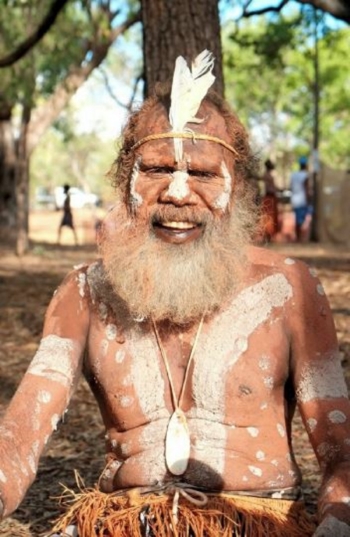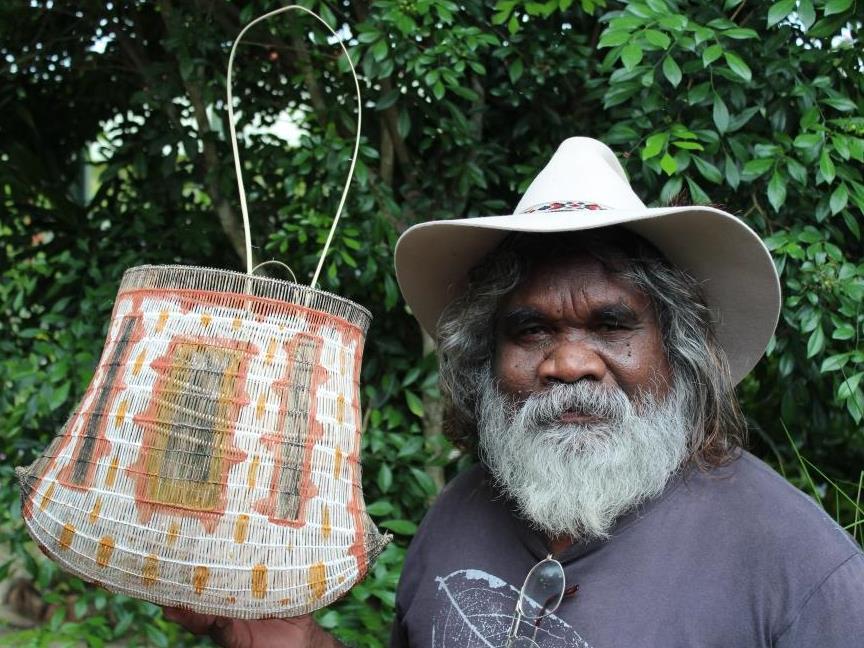Abraham Muriata, IACA Board Director, Senior artist at Girringun Art Centre with Jawun. Image: Commissioned by the British Museum.
For many non-Aboriginal Australians, exposure to Indigenous culture often comes initially through viewing and learning about Aboriginal and Torres Strait Islander art.
In the words of Abraham Muriata, senior artist at Girringun Art Centre and a Board Director of the Indigenous Art Centre Alliance (IACA): ‘You enjoy my culture through my art.’
But all too often, Indigenous artists from regional areas are excluded from conference programs and from opportunities to comment on policy-making decisions pertaining to their art and culture, according to Pam Bigelow, the Manager of IACA, a peak body that advocates for and supports far North Queensland Indigenous art centres.
‘People are afraid of being politically incorrect, when Indigenous artists are actually really happy to speak about their culture and their artwork,’ Bigelow said.
Thirteen art centres are members of IACA, representing some 400 to 500 artists. The organisation also acts as a conduit between government and the sector, and advises on policy making and funding.
Bigelow believes it’s a fear of being insensitive than causes people to overlook regional and remote Aboriginal and Torres Strait Islander artists rather than a policy of deliberate exclusion.
‘It’s a lack of knowing how to approach the artists and a fear that they’ll do the wrong thing, so they do nothing,’ she told ArtsHub.
‘Artists from remote communities are very used to talking to people in the art world. They’re happy to be there and want a say in how things are decided that have an effect on how their art centre is run, and how their art is promoted and their careers are developed.’
Chair of the IACA Board, Philip Rist, added: ‘The artists working in art centres are often the main holders of significant cultural knowledge, lore and custom which is why senior (in age) artists are the holders of this information. Art can be the realisation of knowledge, lore and custom. So peak bodies such as IACA can provide an appropriate and respectful conduit to cultural leaders that should be involved in decision making that affects our people.’
Bigelow pointed to the way Indigenous artists were involved in the Fake Art Inquiry as a perfect example of inclusion, and something that everyone can learn from, moving forward.
‘You can actually learn an incredible amount from Indigenous artists and receive insights that are beneficial to all outcomes from a cultural perspective,’ Bigelow said.

Sid Bruce Short Joe, senior artist and board chair at Pormpuraaw Arts and Culture centre, Laura Dance Festival. Image: Emma Fowler.
Building connections through peak bodies
One of the barriers stopping people reaching out to Indigenous artists is that they’re not sure where to begin, Bigelow believes.
She suggests people contact their nearest Indigenous arts peak body.
‘Peak bodies are here for a reason; there are five of them and they cover most of the country,’ she said. ‘In my world of art centres, that’s your go to. The five majors are: Desart, ANKAAA, Ku Arts, IACA and AACHWA
‘These bodies will direct you to the right people if you want to invite artists and be inclusive. Peak bodies are your connector and they can talk you through what you want to achieve and the best culturally sensitive way to do that.’
Organisations like IACA have the skills, expertise and experience required to assist other organisations in strengthening their communication with and representation of Australia’s First Peoples.
‘People want a pretty picture for the lounge room wall, but it’s not easy for them to move across that cultural barrier and meet and talk with that artist, you know, or maybe just understand a little bit more about where that work has come from, or what it means to those people.
‘All I know is that our board and membership would love the opportunity to be heard.’
Learn more at iaca.com.au.





